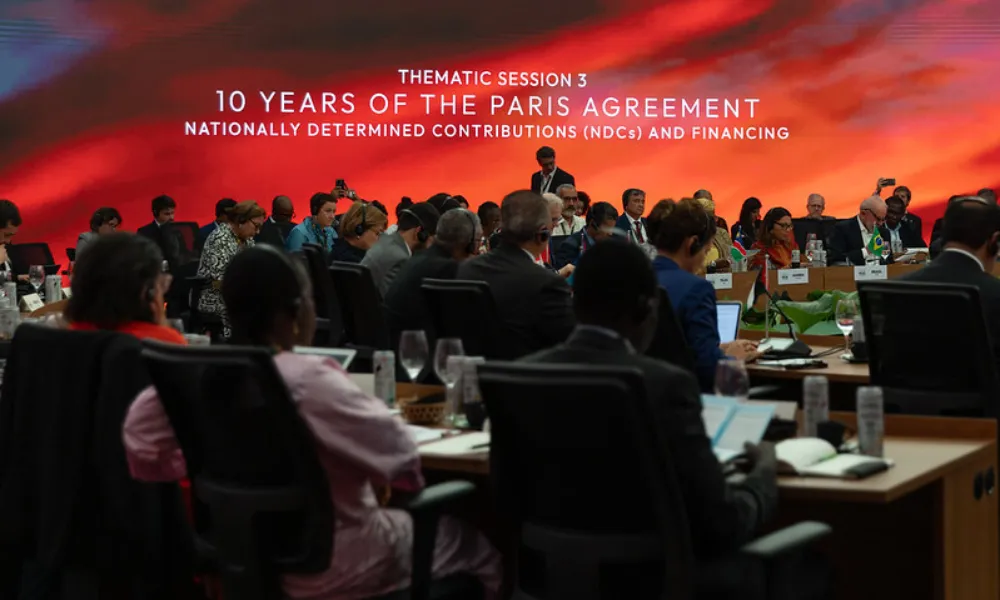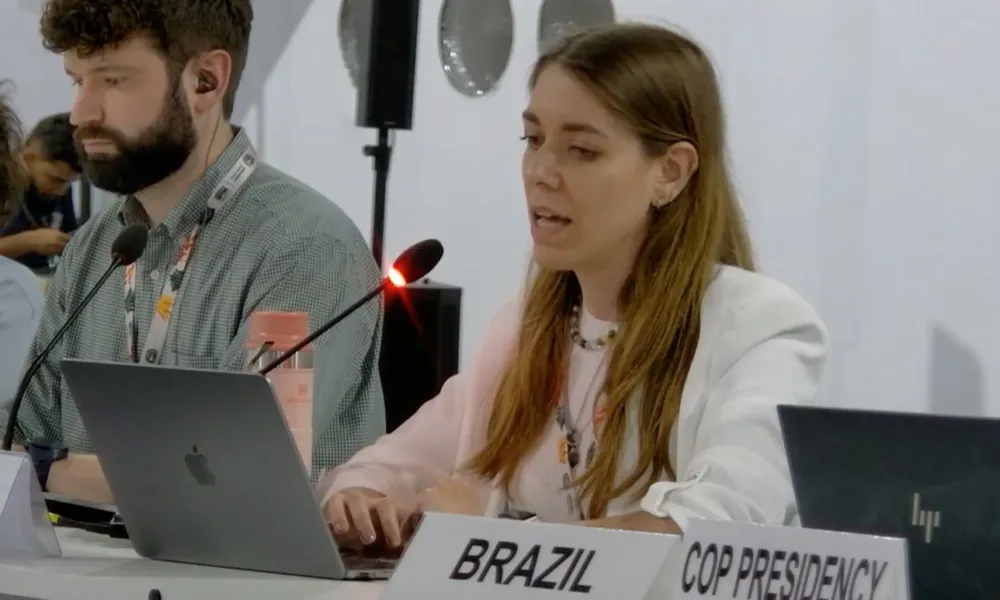
Speaking of slimmed-down numbers, we're all aware this is the first UN climate summit in a decade not to have important political decisions establishing the framework for carbon markets on its agenda. Ten years of hard work came to an end in Baku last year, for which we're all extremely grateful.
This transition from negotiation to implementation and operation of Article 6 means that our workload at COP has lightened – a bit. Now it's about developing and approving methodologies, registering projects and issuing credits, right?
Well, almost. To be sure, we celebrated the approval of the first Paris Agreement Crediting Mechanism methodology, and we've recorded more Article 6.2 memoranda of understanding being signed, so the pace of country-to-country cooperation seems to be picking up.
But there are still some critically important markets-related decisions for this COP to make, not least of which is the very high-profile issue of permanence in nature-based crediting. The PACM's Supervisory Body adopted a standard on "non-permanence and reversals" in methodologies, and this will be discussed by the subsidiary bodies before being formally adopted by the CMA and COP.
We've expressed our concern that the adoption of the standard could impact investment in nature-based removals. Other stakeholders went further, calling the decision "a lopsided focus on ideological consistency [over] operational feasibility". We'll be keeping a close eye on this file in Belém, and we'll bring you all the news from the markets segment of the talks.

Has it been 10 years already? Ahead of the official start of COP30, the Leaders' Summit considered the progress of the Paris Agreement, and launched the Open Coalition on Compliance Carbon Markets. Photo: UNFCCC
If we lift our heads up to look at the broader issues, there's a lot of ground for the COP to cover in these two weeks. NDCs have been coming in thick and fast over the past couple of weeks – including the European Union's target after an eleventh-hour agreement – and we'll no doubt be reading new syntheses of the third round of national commitments in the days to come.
Of course, there's finance as well. The first report of the Baku to Belém Roadmap to $1.3 Trillion was published last week, and its preamble neatly expressed the dilemma that delegates face: "We find ourselves caught between persistent political hurdles in climate negotiations on one side and the real, growing embrace of the net-zero transition by economies and societies on the other."
(The Roadmap also highlighted that "carbon markets can play an important role in channeling finance into verified mitigation outcomes.")
Indeed, outside the realm of climate diplomacy, evidence points ever more strongly at a sense of growing momentum towards net zero.
The International Energy Agency noted in its latest report that "[global] renewable power capacity is projected to increase [by] almost 4,600 GW between 2025 and 2030 – double the deployment of the previous five years."
UN Secretary-General Antonio Guterres celebrated this progress at last week's pre-COP meeting:
"Last year, 90% of new power capacity came from renewables," he said. "Global investment in clean energy reached $2 trillion – $800 billion more than fossil fuels; [and] renewables are now the cheapest source of new electricity in nearly every country."
"The pathways for each country may look different, but the destination must be the same," he added. "A net-zero world, followed consistently by a net negative world - powered by renewables."
These headline figures are being supported by even more action on the ground to speed up the transition, namely by the uptake in carbon markets. You may have been reading our reports from IETA's series of regional climate summits this year, where we have been consistently surprised and gratified by the interest in and appetite for carbon pricing as an effective policy tool to drive decarbonisation. We'll no doubt hear much more on this in the coming two weeks.
And underpinning the momentum that we've been witnessing this year, we were met in Belém by the news that Brazil, China and the EU have launched the Open Coalition on Compliance Carbon Markets, an initiative to standardise and integrate different national carbon markets. Already the new Coalition is signing up new members: Armenia, the UK, Canada, Chile, France, Germany, Mexico and Zambia.
The Coalition's work was informed by a study led by Harvard University and MIT which concluded that a well-designed carbon-pricing coalition can drive large-scale climate action and prevent a chaotic patchwork of border levies – findings that are not dissimilar to IETA's own work with the University of Maryland a couple of years back!
The Coalition was one of several initiatives unveiled at the Leaders' Summit over the weekend; Brazil also launched its Tropical Forests Forever Fund, aimed at raising substantial and permanent funding from both public and private sources.
TFFF aims to provide long-term, results-based financial support to Tropical Forest Countries for the conservation and restoration of their tropical and subtropical moist broadleaf forest.
Monday saw the formal opening plenary, at which UNFCCC executive secretary Simon Stiell told the assembled delegates: "Ten years ago in Paris, we were designing the future – a future that would clearly see the curve of emissions bend downwards."
"The emissions curve has been bent downwards. Because of what was agreed in halls like this, with governments legislating, and markets responding."
Negotiations will get underway on Tuesday, though as we've mentioned above, the market mechanisms don't form part of the official negotiating agenda.
Nonetheless, as we explained in our COP30 Policy Paper (https://www.ieta.org/cop30-policy-paper-advancing-carbon-markets-implementation-at-cop30) , the topic was being discussed from the very start this year. Delegates opened a Second Article 6.2 Ambition Dialogue on Monday to carry on the first Dialogue which was held at SB62 in Bonn earlier this year. Several topics have been outlined for the dialogue, including how to ensure high-integrity cooperative approaches, how higher ambition can be delivered, and technical issues around authorisation and corresponding adjustments. The Dialogue sessions are available on the COP digital platform.
Standing in for our stranded CEO, Agustina Cundari spoke on behalf of IETA on "financing and market signals to advance ambition" during the Ambition Dialogue on Monday. You can view her intervention on the UN website here.

On Article 6.4, Parties will consider the Annual Report developed by the PACM Supervisory Body (itself abbreviated as SBM). They are expected to take note of the report and potentially provide further guidance, and this may or may not include discussions over the issue of non-permanence and reversals as mentioned above.
In addition, COP will need to deal with the timing of authorisation of A6.4ERs and use cases for Article 6.4 Mitigation Contribution Units (MCUs). COP29 mandated the SBM to set a time limit between the date of issuance of A6.4ERs and the provision of a statement of authorisation by the host Party, but no decision has taken this year. There are also diverging views on the use of non-authorised MCUs for voluntary corporate offsetting, and we may hear more on this in Belém.
And it's particularly apt that, ten years after the sunset began to fall on the Clean Development Mechanism, that we may, just maybe, be approaching the end of that particular story. December 31 this year represents the deadline for Designated National Authorities to approve the transition of CDM projects into the PACM. According to the UNFCCC, 3,494 activities were eligible to transition to PACM, but only 1,508 projects from 80 countries requested it. And 93% of these applications are still awaiting approval.
With the Coalition to Grow Carbon Markets, the Open Coalition on Compliance Carbon Markets, the Article 6 Ambition Alliance, and the African Integrity & Equity Principles for Carbon Markets all making their debuts this year, 2025 is definitely turning out to be the year of government engagement. Let's hope that COP30 leaves us with even greater optimism and a long to-do list!
And if you missed our COP30 preview webinar, you can view it here.

On Monday there was relatively little activity at the IETA/ICC Business Hub, with much of the pavilion hall still being set up. Everyone was busy getting oriented, making sure there were enough power sockets, standing in line for the COP venue payment card – no credit cards or cash accepted! – and of course, tracking down the choice coffee stands.
In this daily COP Report we will be reporting on the proceedings at the Business Hub, digesting key takeaways from the daily BINGO Briefing and bringing you the highlights from the key presentations and side events, not just at the Pavilion, but from around the Blue Zone.

All event times are listed in Brasilia time (BRT), which is three hours behind GMT and 11 hours behind Singapore time.
The IETA/ICC Business Hub is located in Pavilion D145 (see image below). It's in area D of the Delegation Pavilions hall, quite close to the main entrance, and our neighbours are Colombia, the World Meteorological Organisation, Saudi Green Buildings Forum and the Oceans pavilion.
IETA has two side event venues within the Hub: the Boardroom and the Side Event Theatre. You can find the IETA schedule of events here (https://www.ieta.org/events/cop30-ieta-businesshub-2) , while the UNFCCC has produced an online schedule of side events here (https://seors.unfccc.int/reports/events_list.html?session_id=COP%2030) .
Tuesday sees IETA's programme of events kick off at 1030 hrs in the Boardroom with a session hosted by Germany's federal environment ministry & Climate Focus. Speakers will discuss how Article 6 can contribute to scaling up the flow of resources to developing countries.
At 1100 hrs the focus switches to Brazil. The session in the Side Event Theatre will unveil new modelling insights on the economic, sectoral, and social impacts of alternative regulatory pathways under the SBCE and Article 6 — exploring how coherent carbon market frameworks can enhance competitiveness and position Brazil as a global climate leader.
At 1330 hrs in the Boardroom, IETA will unveil the results of its annual IETA/PwC GHG Market Sentiment Survey. This year’s edition will revolve around five key themes – the expansion of emissions trading systems, CBAM, CORSIA, Article 6, and the voluntary carbon market – as well as price projections in key jurisdictions. The survey insights will be presented and discussed by a panel of experts and stakeholders.
In the Side Event Theatre at 1330 hrs, the Hedera Foundation will round out the day by presenting a session looking at how to bring order to fragmented market infrastructure. Speakers from key stakeholders will discuss the state of market infrastructure, and the role of international collaboration, data standardisation initiatives, technological tools and other solutions to address a critical risk to market scaling.
Elsewhere on Monday, there will be a side event at 1645 hrs looking at the safeguards needed to ensure that the needs and visions of communities are at the centre of climate action. Speakers will include the Oeko Institute, Carbon Market Watch and the Swiss Lenten Fund. The event will be streamed on the UN website and details are available on the UN side event schedule.
At 1830 hrs, African stakeholders will host a side event to reflect on Africa’s challenges and opportunities within carbon markets. The meeting will also look at how to leverage carbon not just as a source of revenue, but as a strategic tool for development. Details on the UN side event page (link above).